This review focuses on the intricacies of different Tesla chargers. How to quickly charge a Tesla in your own garage will be discussed below. The manufacturer has included a proprietary charger as part of the basic package, but there are other interesting options.
The Tesla Mobile Connector (slow- and medium-speed charging) and the Tesla Wall Connector (charges fast) are differentiated for residential use. Other charging stations are also compatible with Tesla using an adapter.
Tesla Mobile Connector vs. Tesla Wall Connector
The Tesla Mobile Connector (TMC or UMC) is a Level-1 charger that comes with the kit. However, you should understand that the regular charger will charge the battery very slowly. Only about 3 miles of travel after 1 hour of charging, which is usually not enough.
Note: Level-1 devices are those that plug into 120-volt outlets. Level-2 devices are those that plug into 240-volt outlets.
Tesla Wall Connector (TWC) — refers to Level-2 chargers and charges the electric car much faster. The units of power measurement are kilowatts. You can also see the amperes in the device specifications. A kilowatt is equal to the product of amperes over volts.
How to speed up Tesla charging? Increase the number of kilowatts in the charging station.
Tesla Wall Connector
 | 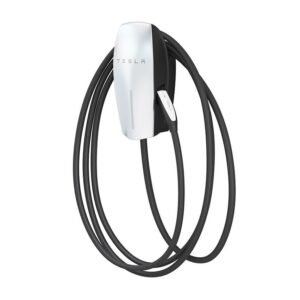 | 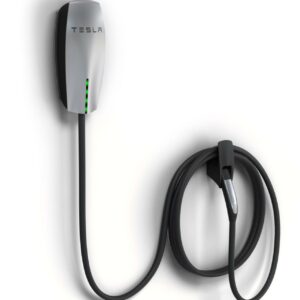 | |
| Tesla Wall Connector Gen 3, 48 Amp, 18 ft | Tesla Gen 2 Wall Connector Charger 80 Amp, 24ft | Tesla Gen 1 High Power Wall Connector Charger 24ft Long | |
| Brand | Tesla | Tesla | Tesla |
| Amperage | 12, 16, 24, 32, 40, 48 | 12, 16, 20, 24, 28, 32, 36, 40, 48, 56, 64, 72, 80 | 12, 16, 24, 32, 40, 64, 80 |
| Voltage | 240 | 240 | 240 |
| Cable length, ft | 18 | 24 | 24 |
| Hardwired | Yes | Yes | Yes |
| Level | 2 | 2 | 2 |
| Wall/Stand | Wall | Wall | Wall |
| Weight | 10 | 20 | 20 |
| Working temperature | -22°F to 122°F | -22°F to 122°F | -22°F to 113°F |
| Warranty | 4 years | n/a | 1 year |
| Certificate | cULus - E351001 | cULus listed for United States and Canada under file number E354307, FCC Part 15. | UL listed under file number E351001, FCC Part 15 |
To begin with, it is worth distinguishing that Wall Connector and Mobile Connector are both Level-2 type chargers, nevertheless they are different devices. Due to the operation from a 240-volt outlet, the Level-2 equipment is able to deliver more power, respectively much faster to charge an electric car, sometimes up to 9 times faster, compared to the slowest chargers. It is also called HPWC (high power wall connector).
The Gen 3 Wall Connector is a stationary charging station. It should be installed by a professional. The equipment is connected directly the power grid and not to a socket.
Wall Connector equipment is suitable for indoor as well as outdoor installations. It can be used to reliably recharge Tesla Model 3, Model S, Model Y and X models.
Different Tesla models have different batteries, so the range after a 1-hour charge will vary, about 25 miles and sometimes more on some models.
The current 3rd-generation TWC was released in early 2020 and has a lower 48-amp capacity than the previous generation (80 amp). However, don’t be too upset, because most Tesla’s released today have a 48-amp AC input power limit. This means that by using the TWC, you are providing your electric car with maximum power.
TWC gen 2 vs. TWC gen 3
There are two versions of the Tesla Wall Charger on the market—Gen 2 and Gen 3 . The main difference between the two is the Power Delivery (PD) feature. The Tesla Wall Charger Gen 3 has PD, which means it can charge your car faster.
The other difference is the faceplate. The Tesla Wall Charger Gen 2 has a white faceplate, while the Tesla Wall Charger Gen 3 has a black faceplate.
Both versions of the Tesla Wall Charger come with a power cord and a cable holster. The gen 2 power cord is about 6 feet long, and the cable holster attaches to the wall charger and holds the power cord in place.
The Tesla Wall Charger Gen 3 also comes with a 24-inch connector cable—longer than the 18-inch connector cable that comes with the Tesla Wall Charger Gen 2. The connector cable is flexible, so it’s easy to move around.
Tesla Wall Charger Gen 3 review
The Tesla Wall Charger Gen 3 is also hardwired, meaning that it’s permanently connected to your electrical panel. If you want to move the wall charger to a different location, you’ll need to hire an electrician to move the wiring.
The Tesla Wall Charger Gen 3 is also WiFi connected, which means you can control it using the Tesla app. You can set up charging schedules, start or stop charging, and check the charging status.
The Tesla Wall Charger Gen 3 is safety certified and comes with a 2-year warranty.
If you’re looking for a faster way to charge your Tesla, the Tesla Wall Charger Gen 3 is the best option. It has PD, which allows it to charge your car up to 40% faster than the standard charger. It also comes with a longer connector cable and a cable holster, so it’s easy to use.
NEMA 14-50 and Tesla Wall Connector
When it comes to fast home charging your Tesla, you have several options.
- You can use the J1772 standard charger (via the adapter that comes with your car)
- You can use Tesla Mobile Connector with extra NEMA 14-50 UMC adapter
- You can buy a Tesla Wall Charger
Tesla Wall Charger Gen 2 vs. Gen 3
To charge your Tesla, you can either use the Tesla Wall Charger Gen 2 or Gen 3. Both come with a power cable and a cable protector. The 2-gen power cord measures approximately 6 feet in length. The cable holster attaches directly to the wall charger and holds the power cord in place. The Wall Charger difference is that the gen-2 model had the ability to connect to a NEMA 14-50 socket, while the latest generation connects directly to the electric grid. And the main difference between the two is the power delivery (PD) feature. The Tesla Wall Charger Gen 2 has PD up to 80A (istead 48A with the gen 3), which means it can charge your car faster. However, you should keep in mind that most Tesla models sold today are limited to 48 amps and an electric car will not accept a higher current. If you want to know more, we have prepared a comparison of Tesla Wall Connector generations.
Alternatives to the Tesla Wall Connector
Customers of evadept.com note some of the disadvantages of the TWC Gen 3 (thin cable, short length of 18ft.) and therefore choose alternative models that deserve respect.
How does a charger with a J1772 connector charge a Tesla? Easy. In the trunk of every Tesla, you’ll see a J1772 adapter, which solves the compatibility issue perfectly.

- #3 Tesla compatibleEmporia Level 2 EV Charging Station (240 Volt, 24ft Cable, 16/24/32/40 for NEMA 14-50 Plug or 48 Amp for hardwired mode) NEMA 14-50 Plug, Indoor/Outdoor, WiFi Enabled$42900Prime
eligibleJan 2, 2026 8:15 PM
Quite often electric car owners choose something else instead of Tesla Wall Connector equipment. There are several simple explanations for this – a longer cable to connect, built-in wireless interfaces provide faster connection speeds, the ability to work from a more powerful outlet, etc. There may be other nuances as well, such as price or warranty period.
Comparison table
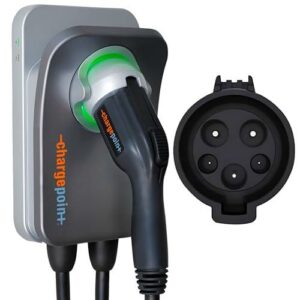 | 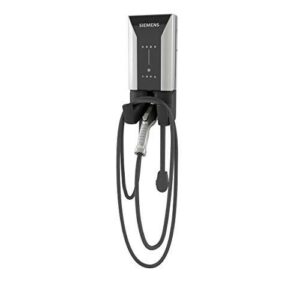 | 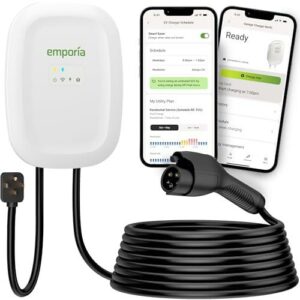 | 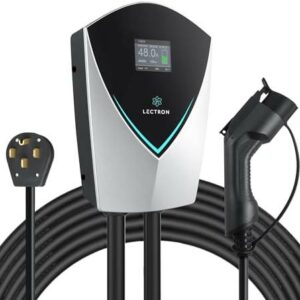 | 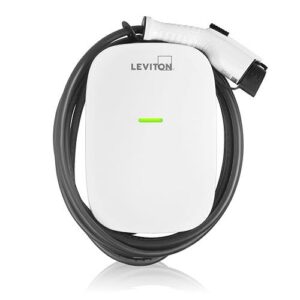 | |
| ChargePoint NEMA 14-50 plug/hardwired Home Charging Station... | Siemens VersiCharge Level 2 Hardwired EV Home Charging stat... | Emporia Level 2 EV Charging Station (240 Volt, 24ft Cable,... | Lectron Level 2 Electric Vehicle (EV) Charging Station (240... | Leviton EV480 Level 2 Hardwired Electric Vehicle (EV) Charg... | |
| Overview | Charge Smarter, Not Just Faster. The Flexibility to Work with Any Home. Works with Any EV. Hardwired connections are eligible up to 50 amps. | A high-powered home device. Has high WiFi signal requirements. | Hardwired connections are eligible up to 48 amps. | This charger offers two connection options and two maximum power options, making it perfect for EV owners. Hardwired connections are eligible up to 48 amps. | |
| Brand | chargepoint | Siemens | Emporia | Lectron | Leviton |
| Amperage | 16, 24, 32, 40, 48, 50 | 12, 16, 24, 32, 40, 48 | 16, 24, 32, 40, 48 | 16, 24, 32, 40, 48 | 48 |
| Cable length, ft | 23 | 20 | 24 | 20 | 18 |
| Outdoor | Yes | Yes | Yes | Yes | Yes |
| Travel/Portable | No | No | No | ||
| Wall/Stand | Wall | Wall | Wall | Wall | Wall |
| Waterproof | Yes | Yes | IP55 | ||
| Weight | 17.6 | 17 | 26.2 | 19.06 | 18.52 |
| Working temperature | -40°F to 113°F | -22°F to 122°F | |||
| Warranty | 3 years | 3 years | 2 years | ||
| Certificate | UL certificate 20190607-E328478 issued 06/07/2019; Type 3R per UL 50E; ENERGY STAR qualified 06/25/19. | cUL listed | EV Charger is not UL certified, it is manufactured to meet the safety criteria defined by these international standards: NEC 625, SAE J1772, UL 817, UL 991, UL 2231, UL 225, and UL 2594 | Energy Star Certified | UL/Energy Star Certified |
Tesla Model 3 Charging Specs and Guide
What are the charging specs for a Tesla Model 3? There are four different variants of the electric car. These range from a 55 kWh battery pack to a 75 kWh battery pack. Here, we’ll go over the different types of charging cables.
Tesla Model 3 charging ports
There are four main EV charging ports in the US. The Tesla Model 3’s charging ports are located on the left side of the vehicle, behind the rear tail light assembly. To open the port, place the Model 3 in Park and press the charging cable button. If you are using the Tesla touchscreen, go to Controls> Charging>Open Charge Port. To access the port using the key fob, press the rear trunk button on the key fob for two to three seconds.
Tesla Model 3 charging cables
If you are looking for a new car and are interested in recharging your electric vehicle, you may want to check out the charging cables and specs for your Model 3. These are designed specifically for this vehicle, and are compatible with Type 2 charging stations. Unlike other charging cables, these Tesla Model 3 charging cables are smaller and lighter, making them convenient to carry and use. Designed in Germany, the cable is durable and easy to use. It also is weatherproof and is available in single or three phase.
Currently, the Tesla Model 3 comes with a minimum charging capability, and you will need a Wall Connector or an additional adapter in order to get the maximum charging speed. If you want to learn how to charge Tesla at non-Tesla charging stations, you will need a special adapter. To help you find the best one, EV Adept recommends cables with the word “Tesla” in the title. The cables are all compatible, however, so make sure to check their compatibility before purchasing. In addition to the cables, you should also check the Tesla Model 3 charging station’s location.
Tesla Model 3 charging options
One of the first questions EV-curious ask about Tesla Model 3 charging options is how much range is provided. Although most EV owners charge their vehicles at home, long-distance travel requires public charging. Tesla has solved this problem by developing the Supercharger network. Despite the limitations of charging your Model 3, there are several countries where you can find convenient charging options. The following are some of those countries. Let’s take a closer look.
The first option is to use a Supercharger network. These stations use the CCS standard, which means that Teslas can use these networks for charging. However, drivers must have a CCS adaptor if they want to use a Supercharger. These chargers also use a Type 2 connector. If you have a Tesla Destination unit, you can use the same charger to charge your Model 3.
Best EV Charger for Tesla
Tesla owners have a number of choices when it comes to EV chargers. The best one for you will depend on your needs and budget.
The Tesla Mobile Connector with NEMA 5-15 Adapter is the simplest option. It plugs into a standard 120-volt outlet and provides 12 amps of power, which is enough for most charging needs. If you need more power, the Tesla Mobile Connector with NEMA 14-50 Adapter is a better choice. It has a higher amperage rating and can be used with 240-volt outlets (up to 32 amp for the TMC).
The Tesla Wall Connector gen 3 is the most powerful option, providing up to 48 amps of power (or 80 amps for gen 2).
If you don’t have a Tesla, there are a number of other great options for EV chargers. The JuiceBox EV Charger is our top pick. It has the highest power output of any non-Tesla charger, providing up to 40 amps.
If you’re looking for a smart charger, the ChargePoint Home Flex EV Charger is a great option. It has a built-in timer and WiFi connection, so you can control charging remotely.
The Wallbox Pulsar Plus Level-2 EV Charger is another great choice, with a high power output and a compact design.
Finally, the Grizzl-E Duo EV Charger is an affordable option that’s perfect for basic charging needs for 2 cars. It’s perfect for high-power charging needs or when multiple vehicles need to be charged at the same time. It doesn’t have any advanced features, but it’s very reliable and durable.
Whichever charger you choose, make sure it meets your needs and budget. With the right EV charger, you can enjoy a convenient, reliable charging experience.
EV chargers are an essential part of any electric vehicle owner’s life. Whether you have a Tesla or another electric car, it’s important to have a charger that meets your needs. We hope this list we’ve compiled a list of the top EVSE for EV owners will help you in choosing the best Tesla charger for you.
Contents
- 1 Tesla Mobile Connector vs. Tesla Wall Connector
- 2 Tesla Wall Connector
- 3 TWC gen 2 vs. TWC gen 3
- 4 Tesla Wall Charger Gen 3 review
- 5 NEMA 14-50 and Tesla Wall Connector
- 6 Alternatives to the Tesla Wall Connector
- 7 Comparison table
- 8 Tesla Model 3 Charging Specs and Guide
- 9 Tesla Model 3 charging ports
- 10 Tesla Model 3 charging cables
- 11 Tesla Model 3 charging options
- 12 Best EV Charger for Tesla
Reference:
https://www.tesla.com/sites/default/files/blog_attachments/ms_hpwc_installation_guide.pdf

I’ve been using Tesla’s Mobile Connector for about a year now. It’s been a lifesaver on road trips. Last summer, I visited my aunt in a remote area, and the nearest supercharger was miles away. The Mobile Connector came to the rescue. It’s slower than a supercharger, but the convenience is unmatched. Anyone else have similar experiences?
Absolutely! The Mobile Connector has been a game-changer for me too. I often visit my family cabin in the Canadian Rockies, and having the flexibility to charge anywhere is invaluable.
I’m considering getting a 240 V outlet installed for my Model 3. Anyone have an idea of the average cost in the Midwest?
I’m in Ohio and had a 240 V outlet installed last year. Cost me around $1,000, but prices can vary based on the electrician and the complexity of the installation.
For those new to Tesla home charging, here’s a quick guide: 1. Determine the best charging option for your needs (Mobile Connector vs. 240 V outlet). 2. If going for the 240 V, get a quote from a local electrician. 3. Ensure your home’s electrical system can handle the added load. 4. Once installed, make it a habit to plug in overnight. Happy charging!
I’m on a tight budget and wondering if the Mobile Connector is sufficient for daily use. I drive about 30 miles a day. Thoughts?
The Mobile Connector should be more than enough for your daily needs. I drive roughly the same distance and it’s been perfect for me. Plus, you’ll save on installation costs.
I recently got the 240 V outlet installed, but I’ve noticed some fluctuations in charging speed. Sometimes it’s super fast, other times it’s sluggish. Anyone else facing this?
I’m torn between sticking with the Mobile Connector or upgrading to the 240 V outlet. I know the latter is faster, but is the difference in speed worth the installation cost?
It really depends on your daily mileage. If you’re driving long distances regularly, the 240 V is a game-changer. But for shorter commutes, the Mobile Connector should suffice.
A little tip for those using the Mobile Connector: Always ensure the plug is clean and free from debris. I once had a slow charging issue, and it turned out there was some dirt in the plug. A quick clean, and it was back to normal!
Just a heads up, Tesla is offering a limited-time discount on their home charging equipment. If you’ve been on the fence, now might be a good time to grab one.
Anyone in the NYC area interested in a group buy for Tesla’s home charging equipment? I’ve spoken to a distributor who’s willing to give a discount for bulk orders.
Always ensure your home’s electrical system can handle the added load before installing any charging equipment. I’ve heard of a few instances where inadequate systems caused issues. Safety first, folks!
Been using the Tesla NEMA 10-30 Adapter for a few months now. My old house has a NEMA 10-30 outlet in the garage from an old dryer. The adapter’s been a lifesaver. It’s consistent and I haven’t noticed any heating issues. Anyone else find it as reliable as I do?
I’ve had a similar experience. It’s been super reliable for me. Though, I did have to ensure I had the Gen 2 UMC for compatibility.
I got my Tesla before December 2017. So, I’m guessing I have the Gen 1 UMC. Can anyone confirm if the NEMA 10-30 Adapter won’t work for me?
That’s correct. If you have the Gen 1 UMC, you’ll need a different adapter. I’d recommend checking Tesla’s official site for more info.
For those new to using the NEMA 10-30 Adapter, always ensure the outlet you’re plugging into is in good condition. I once plugged into a worn-out outlet and it caused some minor issues. Regularly inspect both the outlet and the adapter for any signs of wear or damage. Safety first!
I’m on a tight budget and the official Tesla NEMA 10-30 Adapter is a bit pricey for me. Any recommendations for third-party alternatives that are reliable?
I’d be cautious with third-party adapters. Sometimes they can be hit or miss. If budget’s a concern, maybe look for a used official one?
I’ve noticed my NEMA 10-30 Adapter gets quite warm during charging. Not scalding, but definitely warm. Is this normal or should I be concerned?
It’s normal for it to get a bit warm, but if it’s excessively hot, I’d get it checked. Better safe than sorry.
I’m torn between the NEMA 10-30 and the NEMA 14-50 adapters. I have both outlets available. Any thoughts on which one’s better for a Model 3?
A little tip for those using the NEMA 10-30 Adapter: Don’t leave it exposed to the elements. I keep mine in a small weatherproof box when not in use. It’s kept it in pristine condition.
For those looking to grab the NEMA 10-30 Adapter, I saw it on sale at a local retailer. Might be worth checking out if you’re in the market for one.